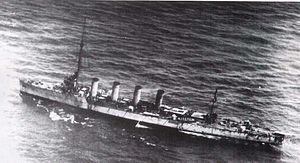Novara-class cruiser

Novara, after the Battle of the Otranto Straits
|
|
| Class overview | |
|---|---|
| Name: | Novara class |
| Builders: | |
| Operators: | |
| Preceded by: | Admiral Spaun |
| Built: | 3 |
| In service: | 1914-1929 |
| Completed: | 3 |
| Retired: | 3 |
| General characteristics | |
| Type: | Light cruiser |
| Displacement: |
|
| Length: | 130.6 m (428 ft 6 in) o/a |
| Beam: | 12.77 m (41 ft 11 in) |
| Draught: | 4.95–5.3 m (16.2–17.4 ft) |
| Propulsion: |
|
| Speed: | 27 knots (50 km/h; 31 mph) |
| Range: | 1,600 nautical miles (3,000 km; 1,800 mi) at 24 kn (44 km/h; 28 mph) |
| Complement: | 340 |
| Armament: |
|
| Armour: |
|
The Novara class, known as Rapidkreuzer or Helgoland-Klasse (in English literally rapid cruiser ) was a class of light scouting cruisers of the Austro-Hungarian Navy active during World War I. The ships were an improved design of the earlier SMS Admiral Spaun , which had been laid down in 1908.
Main armament for the ships were nine 10 cm (3.9 in) guns and six twin torpedo tubes, an improvement over Admiral Spaun by two 10 cm guns. The lightly armored ships had a top speed of 27 knots (50 km/h; 31 mph). Each ship had one open pivot mount 7 cm (2.8 in) Škoda 7 cm K16 gun for anti-aircraft defense after a 1917 refit. The weak point of the Novara class was its relatively light armament. Guns of 12 or 15 cm (5 or 6 in) were considered but not added due to the war situation.
Another three ships with 12 cm guns and maximum speed of 30 kn (56 km/h; 35 mph), projected as a replacement of Zenta-class, never got over planning phase.
Three ships were built and commissioned:
Together with the Tátra-class destroyers they were ideally suited to the naval warfare of the Adriatic Sea. Numerous fast raids on Italian ports were undertaken, the most spectacular action was the successful attack of Novara, Helgoland, and Saida on the Otranto Barrage on 15 May 1917; the three cruisers, along with two destroyers and three German U-boats sank 14 trawlers.
After the war the ships were given to the victorious Entente powers: France incorporated Novara under the name Thionville into its fleet (scrapped in 1942). Italy took over Helgoland and Saida as Brindisi and Venezia (both scrapped in 1937).
...
Wikipedia
